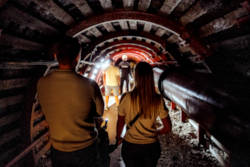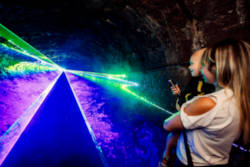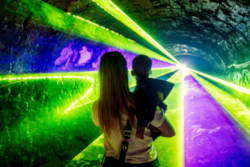Kopalni Uranu Kowary
Sztolnie Kowary
Useful Information
| Location: |
Podgórze 55, 58-530 Kowary.
Between Jelenia Góra (Hirschberg) and Karpacz. At Kowary (Schmiedeberg), signposted. Parking at the hotel is reserved for hotel guests. The parking lot is 500 m from the mine, 10 minutes walk. (50.758994, 15.847441) |
| Open: |
All year daily 10-16. Tours every hour on the hour. Online booking mandatory. [2025] |
| Fee: |
Adults PLN 49, Children (7-18) PLN 45, Children (0-6) PLN 1, Seniors (65+) PLN 45, Families (2+2) PLN 160. [2025] |
| Classification: |
 Iron Mine Iron Mine
 Uranium Mine Uranium Mine
 Radontherapy Radontherapy
|
| Light: |
 Electric Light Electric Light
 Son et Lumière Son et Lumière
|
| Dimension: | T=8 °C, H=98 %. |
| Guided tours: | L=1,200 m, D=60 min, Min=2, Max=40. |
| Photography: | allowed |
| Accessibility: | yes |
| Bibliography: | |
| Address: |
Jelenia Struga Medical SPA Sp. z o.o., ul. Podgórze 55, 58-530 Kowary, Tel: +48-75-75-28-458, Tel: +48-796-599-774.
E-mail: |
| As far as we know this information was accurate when it was published (see years in brackets), but may have changed since then. Please check rates and details directly with the companies in question if you need more recent info. |
|
History
| 12th century | first mining in the area. |
| 1808 | iron mine opened. |
| 1850 | beginning of flourspar mining. |
| 1860 | mine closed. |
| 1945 | Polish/Russian uranium mining started. |
| 1948 | uranium mining at Liczyrzepa Mine started. |
| 1973 | mine closed, processing plant taken over by Wrocław University of Science and Technology, which conducted research on explosives and offered classes to students in mining operations. |
| 20-APR-2000 | show mine opened to the public. |
| 2002 | radon tunnel reopened. |
Geology
At Kowary, uranium was found bordering the granite with metamorphic rocks. The ores are seams of hydrothermal origin, both the metamorpic rocks and the ores are a result of the granite intrusion. The typical minerals of the deposit are iron ores, fluorite, calcite, silver, uraninite. They form of irregular pockets, lenses, and crusts, generally a mix of various ore minerals and other minerals, frequently they form spectacular crystals.
Description



The Kopalnia Liczyrzepa (Liczyrzepa Mine) at Kowary was originally an iron mine, named after Liczyrzepa (Rübezahl), a sort of "mountain king" and the lead actor of many legends. Mining primarily for iron started in the area during the 12th century, the main ores were magnetite and hematite. The earliest written mention of the mines was in 1347. Like many iron mines with high grade ore but hard to mine seams, it became unprofitable and was abandoned. There was some fluorite mining too, during the mid-19th century. The Liczyrzepa Mine was actually located on the other side of the hill, and the mine site and slag heaps are over there, but some tunnels crossed the hill and so the show mine is today operated from this side.
After World War II, with the beginning of the Cold War and the run for the Atomic Bomb, it was reactivated as a Uranium Mine named Kopalni Uranu Kowary (Kowary Uranium Mine). 20 tunnels were dug for the production of uranium between 1945 and 1973, by a Polish-Russian company with the code name Zakłady Przemysłowe R-1 (industrial plants R-1). The ore from this mine was important for the production of the first Russian atomic bombs. Obviously the mining activities were top secret at that time. Between 1948 and 1973 about 470 tons of uranium ores were mined at the Liczyrzepa mine, other sources estimate 650 tons or even 850 tons. With an average content of 0.3 % of uranium even the lowest estimate equals 1.4 tons of pure uranium. However, only Uranium 235 was used for the bombs, Uranium 238 is not radioactive, and the radioactive isotope is only a small portion of the uranium. Uranium 238 is used as a very heavy metal, for example, to make very heavy bullets with high impact energy.
In Poland, uranium ore was mined in five mines. Four of them, Kowary, Kletno, Radoniów and Kopaniec, were located in the Sudetes, Rudki near Nowa Słupia is located in the Świętokrzyskie Mountains. The first two are open as show mines.
Although the uranium mining was top secret for many decades, the mine became a little more public after a radon therapy tunnel was opened in 1974. Named Sztolnie Kowary (Kowary Tunnel) it was the core of the Cieplice Health Resort. It was one of only three radon therapy centres in Europe at this time. Radon is a natural gas, belonging to the inert gasses, and it generally does not react very easily. Natural radon has a low natural radioactivity and is thus not exactly healthy. As it is not incorporated, its actually inert, there are no dangers of contamination, but on the other hand, the radioactivity is the only scientifically accepted effect on the body. Obviously the healing effects of radon are a little dubious. However, postulated dangers of radon are exaggerated and there is definitely no danger to visitors or patients. Probably to the people working at the site if they spend a lot of time in the tunnel over the year. Radon therapy was very popular during socialist times, but it was abandoned in 1990, as a result of the many changes after the end of the Cold War. It simply lacked financial resources. The spa was renovated in 2002, and the radon therapy reopened, it is today called "Jelenia Struga" Hotel. It is located at the entrance to the show mine as it uses the same tunnel, although the hotel has a separate entrance in the basement. But as the hotel is in operation again, the parking lot is dedicated only to hotel guests, visitors to the mine have to park 500 m down the valley and walk 10 minutes to the mine.
The tours are made in the Sztolnie Kowary (Kowary Tunnel) which is entered through the original entrance. Unlike other show mine tours they do not concentrate on the technology and the social problems. Actually the tour is more like a laser show with dioramas, the main topics are the uranium mining and its implications, local legends and unique minerals. The entire exhibition is interactive and rather modern, less didactic and more entertaining. Quite funny is the fact that they provide "certified radiation safety compliance". This is obviously a joke, as the uranium ore has a rather low content of Uranium 235 and the radiation in the tunnel is probably lower than the natural radiation on a mountain. The guides are praised for their knowledge, expertise, and sense of humor. They actually tell funny anecdotes as well as strange local legends.
A real danger exists nearby. The mined ore was milled and leached in a uranium mill to extract the uranium. The overburden was pumped as sludge into a sedimentation pond, where it is until today. While actual waste rock is not a problem at all, other ores oxidizing and releasing poisonous substances and small remains of uranium ore which release radioactive substances are a problem. The seepage water is a continuous threat to ground and surface waters.
- See also
 Search DuckDuckGo for "Sztolnie Kowary"
Search DuckDuckGo for "Sztolnie Kowary" Google Earth Placemark
Google Earth Placemark OpenStreetMap
OpenStreetMap Kopalnia Liczyrzepa
Kopalnia Liczyrzepa  - Wikipedia (visited: 02-JUN-2022)
- Wikipedia (visited: 02-JUN-2022) Sztolnie Kowary
Sztolnie Kowary  - Wikipedia (visited: 02-JUN-2022)
- Wikipedia (visited: 02-JUN-2022) Discover the Secrets of the Kowary Uranium Mine, official website (visited: 07-JUL-2025)
Discover the Secrets of the Kowary Uranium Mine, official website (visited: 07-JUL-2025) Jelenia Struga Spa (visited: 09-JUL-2025)
Jelenia Struga Spa (visited: 09-JUL-2025) Sztolnie Kowary w Kopalni Liczyrzepa
Sztolnie Kowary w Kopalni Liczyrzepa  (visited: 02-JUN-2022)
(visited: 02-JUN-2022) Holding uranium in my hand (visited: 02-JUN-2022)
Holding uranium in my hand (visited: 02-JUN-2022) Rübezahl/Liczyrzepa mine, Kowary - mindat.org (visited: 02-JUN-2022)
Rübezahl/Liczyrzepa mine, Kowary - mindat.org (visited: 02-JUN-2022)
 Index
Index Topics
Topics Hierarchical
Hierarchical Countries
Countries Maps
Maps